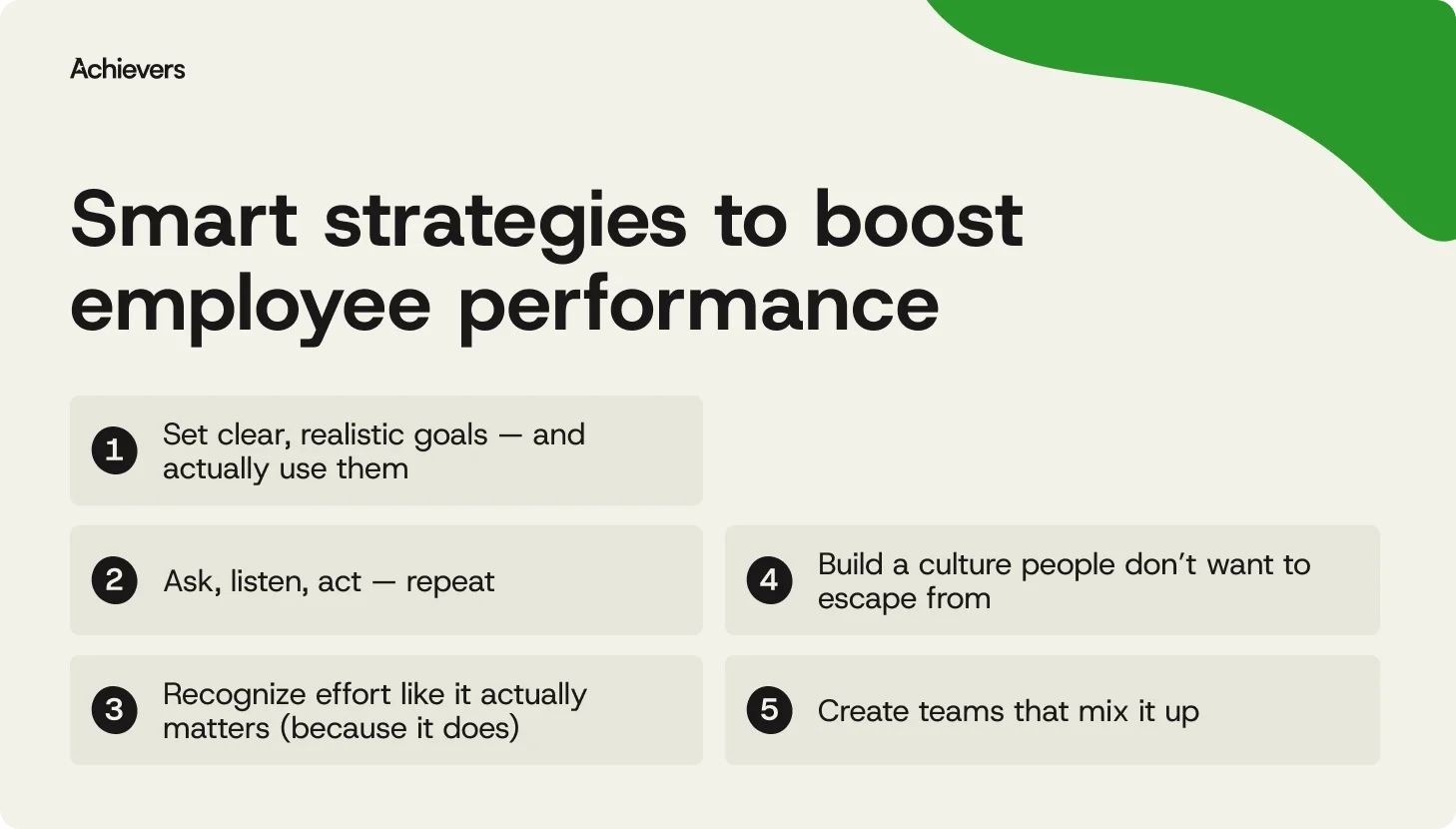Table of contents
Create a culture that means business™
Schedule a demo with an Achievers solution expert today.
Achieving success starts with people — engaged, motivated, high-performing people. But better performance doesn’t happen by accident. It takes more than good intentions or the occasional team lunch. Driving real business results means understanding what truly fuels motivation, focus, and long-term commitment: recognition, feedback, growth, and a culture that actually walks the talk.
Of course, every employee is different, and performance is shaped by a hundred small moments — not one magic lever. It’s complex, sure. But that’s exactly where the right employee performance management strategies (and the right tools) can make all the difference.
With a bit of intention and a platform built to support the behaviors that matter most, unlocking performance becomes not just possible — but sustainable. Here’s how to get started.
10 proven ways to improve employee performance
Performance isn’t just about hitting targets — it’s about building the kind of culture where people are equipped, empowered, and energized to do their best work. That doesn’t happen by chance. From setting goals to giving recognition that actually resonates, these 10 steps will help you boost performance across your organization — without burning anyone out in the process.

1. Set clear, realistic goals — and actually use them
Employees can’t exceed expectations if those expectations feel like a moving target. Set goals that are ambitious, measurable, and human — not heroic. During reviews, revisit them using feedback from peers, clients, and yes, recognition data. And if someone misses the mark? Don’t default to blame. Use it as a coaching opportunity. The real win is creating a culture where feedback is a two-way street and performance is a shared journey. Bonus: employees with clear goals are more likely to be committed to their organization. Coincidence? Definitely not.
2. Build a culture people don’t want to escape from
Culture isn’t about beanbags and free snacks. It’s about belonging, purpose, and feeling like your work matters. The best-performing teams operate in environments that are safe, supportive, and psychologically healthy — and it shows. Companies with strong cultures see 31% less turnover. Want in? Start by defining real values (not just aspirational posters), and recognize employees who embody them. Create space for every voice and invest in well-being — emotional, physical, and mental. Because when people feel good, they do good. And when they don’t? Well… that’s when the resumes start flying.
3. Recognize effort like it actually matters (because it does)
Recognition shouldn’t be an annual event or a mysterious manager-only ritual. When done right — frequently, specifically, and socially — it becomes the engine that powers performance. The best companies reward effort in the moment, not six months later. And it pays off: companies using recognition and incentives report 89% higher engagement and 87% better retention. Use a platform that lets people recognize each other easily (on any device) and offers personalized rewards that actually motivate. Pro tip: “Good job” is fine. “Good job on X that helped Y” is better.
4. Ask, listen, act — repeat
Your employees know what’s working (and what’s not). All you have to do is ask. Frequent feedback via surveys, one-on-ones, and AI-driven tools helps managers stay tuned into team needs. But here’s the thing: asking without acting is worse than not asking at all. Use engagement data to spot trends and prioritize the right issues. Tackle one or two key challenges at a time, not everything all at once. When employees see their feedback lead to real change, trust grows. And where there’s trust, performance follows.
5. Keep morale higher than your email count
When morale dips, everything dips — productivity, collaboration, retention, even health. But morale isn’t magic; it’s built through trust, autonomy, and regular recognition. According to the Achievers Workforce Institute, recognizing employees at least monthly can double engagement. That’s a lot of ROI for a thank-you. Empower managers to recognize publicly and often, avoid micromanaging, and support flexibility. Keep communication open, and make sure your people feel seen and heard — not just supervised. It’s harder to feel burned out when you actually feel appreciated.
6. Make self-care more than a slide in your onboarding deck
Burnout is a performance killer — and it’s alarmingly common. With over half of workers reporting emotional exhaustion, companies can’t afford to ignore well-being. That means putting self-care on the agenda, not just on a poster. Offer mental health support, meditation apps, wellness programs, and flexible time off that’s truly encouraged (not just “available”). Recognize employees who take steps to recharge — and lead by example. When people feel balanced, they bring their best. When they don’t, they bring their burnout. It’s a simple equation.
7. Invest in growth — and mean it
Want employees to perform better? Help them get better. Nearly 94% of workers say they’d stay longer at companies that invest in their development. Offer training, access to certifications, and support for continuing education. Better yet, connect them with mentors and leadership coaches. Encourage managers to shift from taskmasters to coaches — building trust, confidence, and capability. When growth feels real and personal, employees are more engaged, more loyal, and more ready to take on new challenges. Bonus: it’s a great retention strategy disguised as professional development.
8. Give people the tools to thrive (not just survive)
Even the best employees can’t shine if they’re stuck with clunky systems and outdated tools. Provide platforms that support real-time recognition, feedback, and collaboration — and that actually integrate into daily workflows. The right tech simplifies everything, from celebrating wins to understanding what’s working (and what’s not). Look for tools that give leaders meaningful insights and empower employees to engage on their own terms. Because when the tools work, the people do too. And no one wants to spend their day fighting with a spreadsheet.
9. Break down silos — build up results
Collaboration shouldn’t be an uphill battle. When teams work together across functions, they solve problems faster, spark innovation, and create stronger outcomes. But it doesn’t happen by accident. Encourage cross-functional projects, build shared goals, and invest in communication tools that make it easy to stay connected. Pair that with recognition across teams — not just within them — and watch silos start to dissolve. When people see the bigger picture, they’re more motivated to contribute to it. And that’s where performance really levels up.
10. Ditch the annual review-only model
One big, anxiety-inducing conversation a year won’t cut it anymore. Today’s employees need ongoing feedback and coaching to stay on track, feel supported, and grow. Encourage managers to schedule regular check-ins focused on progress, blockers, and future goals. Make feedback timely, balanced, and actionable. Use engagement tools to collect peer insights and supplement manager coaching. When people know where they stand and what’s next, they’re more confident and motivated. Performance management doesn’t have to be scary. In fact, it works better when it isn’t.
Boost employee performance with Achievers
Peak performance doesn’t come from pressure — it comes from purpose. When employees feel supported, recognized, and connected to their goals, they don’t just meet expectations — they surpass them. That’s where Achievers comes in.
We help organizations build the kind of culture where recognition is frequent, feedback is actionable, and goals actually mean something. From real-time insights to seamless integrations and a global rewards marketplace, Achievers equips leaders with everything they need to inspire performance that lasts.
Because when people feel seen, heard, and appreciated, great work follows. Ready to shape your workforce? Let’s get started.



